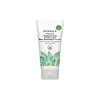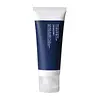What's inside
What's inside
 Key Ingredients
Key Ingredients

 Benefits
Benefits

 Concerns
Concerns

 Ingredients Side-by-side
Ingredients Side-by-side

Water
Skin ConditioningAloe Barbadensis Leaf Juice
Skin ConditioningGlycerin
HumectantCaprylic/Capric Triglyceride
MaskingGlyceryl Stearate Se
EmulsifyingGlyceryl Stearate
EmollientGlyceryl Stearate Citrate
EmollientStearyl Alcohol
EmollientTocopheryl Acetate
AntioxidantSodium Hyaluronate
HumectantVaccinium Macrocarpon Seed Oil
Skin ConditioningSimmondsia Chinensis Seed Oil
EmollientElaeis Guineensis Oil
EmollientOlea Europaea Fruit Oil
MaskingPanthenol
Skin ConditioningCamellia Sinensis Leaf Extract
AntimicrobialChamomilla Recutita Flower Extract
MaskingPinus Pinaster Bark Extract
AntioxidantButyrospermum Parkii Butter
Skin ConditioningAllantoin
Skin ConditioningCetearyl Alcohol
EmollientCetyl Alcohol
EmollientCetearyl Glucoside
EmulsifyingXanthan Gum
EmulsifyingSodium Hydroxide
BufferingPhenoxyethanol
PreservativeEthylhexylglycerin
Skin ConditioningWater, Aloe Barbadensis Leaf Juice, Glycerin, Caprylic/Capric Triglyceride, Glyceryl Stearate Se, Glyceryl Stearate, Glyceryl Stearate Citrate, Stearyl Alcohol, Tocopheryl Acetate, Sodium Hyaluronate, Vaccinium Macrocarpon Seed Oil, Simmondsia Chinensis Seed Oil, Elaeis Guineensis Oil, Olea Europaea Fruit Oil, Panthenol, Camellia Sinensis Leaf Extract, Chamomilla Recutita Flower Extract, Pinus Pinaster Bark Extract, Butyrospermum Parkii Butter, Allantoin, Cetearyl Alcohol, Cetyl Alcohol, Cetearyl Glucoside, Xanthan Gum, Sodium Hydroxide, Phenoxyethanol, Ethylhexylglycerin
Water
Skin ConditioningButyrospermum Parkii Butter
Skin ConditioningDipropylene Glycol
HumectantGlycerin
HumectantCetearyl Alcohol
EmollientPolyglyceryl-3 Methylglucose Distearate
EmulsifyingBeeswax
Emulsion StabilisingSorbitan Sesquioleate
EmulsifyingGlyceryl Stearate
EmollientPanthenol
Skin ConditioningSodium Hyaluronate
HumectantPrunus Amygdalus Dulcis Oil
Skin ConditioningOlea Europaea Fruit Oil
MaskingSimmondsia Chinensis Seed Oil
EmollientPersea Gratissima Oil
Skin ConditioningAllantoin
Skin ConditioningPhellodendron Amurense Bark Extract
Skin ConditioningCoptis Japonica Extract
AntimicrobialScutellaria Baicalensis Root Extract
AstringentScrophularia Buergeriana Extract
Skin ConditioningPiper Methysticum Root Extract
Skin ConditioningGardenia Florida Fruit Extract
Skin ConditioningAstragalus Membranaceus Root Extract
EmollientCnidium Officinale Root Extract
Skin ConditioningPanax Ginseng Root Extract
EmollientGinkgo Biloba Leaf Extract
Skin ConditioningCoix Lacryma-Jobi Ma-Yuen Seed Extract
Skin ConditioningCurcuma Longa Root Extract
MaskingMorus Bombycis Leaf Extract
SmoothingLycium Chinense Fruit Extract
AntioxidantSophora Flavescens Root Extract
AntioxidantGlycyrrhiza Uralensis Root Extract
Skin ConditioningSodium Polyacryloyldimethyl Taurate
Emulsion StabilisingGlyceryl Caprylate
EmollientCaprylyl Glycol
EmollientButylene Glycol
HumectantHydrogenated Polydecene
EmollientXanthan Gum
EmulsifyingTrideceth-10
CleansingDisodium EDTA
Tocopherol
Antioxidant1,2-Hexanediol
Skin ConditioningWater, Butyrospermum Parkii Butter, Dipropylene Glycol, Glycerin, Cetearyl Alcohol, Polyglyceryl-3 Methylglucose Distearate, Beeswax, Sorbitan Sesquioleate, Glyceryl Stearate, Panthenol, Sodium Hyaluronate, Prunus Amygdalus Dulcis Oil, Olea Europaea Fruit Oil, Simmondsia Chinensis Seed Oil, Persea Gratissima Oil, Allantoin, Phellodendron Amurense Bark Extract, Coptis Japonica Extract, Scutellaria Baicalensis Root Extract, Scrophularia Buergeriana Extract, Piper Methysticum Root Extract, Gardenia Florida Fruit Extract, Astragalus Membranaceus Root Extract, Cnidium Officinale Root Extract, Panax Ginseng Root Extract, Ginkgo Biloba Leaf Extract, Coix Lacryma-Jobi Ma-Yuen Seed Extract, Curcuma Longa Root Extract, Morus Bombycis Leaf Extract, Lycium Chinense Fruit Extract, Sophora Flavescens Root Extract, Glycyrrhiza Uralensis Root Extract, Sodium Polyacryloyldimethyl Taurate, Glyceryl Caprylate, Caprylyl Glycol, Butylene Glycol, Hydrogenated Polydecene, Xanthan Gum, Trideceth-10, Disodium EDTA, Tocopherol, 1,2-Hexanediol
 Reviews
Reviews

Ingredients Explained
These ingredients are found in both products.
Ingredients higher up in an ingredient list are typically present in a larger amount.
Allantoin is a soothing ingredient known for its protective and moisturizingg properties. Because of this, it is often added to products with strong active ingredients.
Studies show higher concentrations of this ingredient can promote wound healing.
Though it can be derived from the comfrey plant, allantoin is produced synthetically for cosmetic products to ensure purity.
Learn more about AllantoinThis ingredient is also known as shea butter. It is an effective skin hydrator and emollient.
Emollients help soothe and soften your skin. It does this by creating a protective film on your skin. This barrier helps trap moisture and keeps your skin hydrated. Emollients may be effective at treating dry or itchy skin.
Shea butter is rich in antioxidants. Antioxidants help fight free-radicals, or molecules that may harm the body. It is also full of fatty acids including stearic acid and linoleic acid. These acids help replenish the skin and keep skin moisturized.
While Shea Butter has an SPF rating of about 3-4, it is not a sunscreen replacement.
Shea butter may not be fungal acne safe. We recommend speaking with a professional if you have any concerns.
Learn more about Butyrospermum Parkii ButterCetearyl alcohol is a mixture of two fatty alcohols: cetyl alcohol and stearyl alcohol. It is mainly used as an emulsifier. Emulsifiers help prevent the separation of oils and products. Due to its composition, it can also be used to thicken a product or help create foam.
Cetearyl alcohol is an emollient. Emollients help soothe and hydrate the skin by trapping moisture.
Studies show Cetearyl alcohol is non-toxic and non-irritating. The FDA allows products labeled "alcohol-free" to have fatty alcohols.
This ingredient is usually derived from plant oils such as palm, vegetable, or coconut oils. There is debate on whether this ingredient will cause acne.
Due to the fatty acid base, this ingredient may not be Malassezia folliculitis safe.
Learn more about Cetearyl AlcoholGlycerin is already naturally found in your skin. It helps moisturize and protect your skin.
A study from 2016 found glycerin to be more effective as a humectant than AHAs and hyaluronic acid.
As a humectant, it helps the skin stay hydrated by pulling moisture to your skin. The low molecular weight of glycerin allows it to pull moisture into the deeper layers of your skin.
Hydrated skin improves your skin barrier; Your skin barrier helps protect against irritants and bacteria.
Glycerin has also been found to have antimicrobial and antiviral properties. Due to these properties, glycerin is often used in wound and burn treatments.
In cosmetics, glycerin is usually derived from plants such as soybean or palm. However, it can also be sourced from animals, such as tallow or animal fat.
This ingredient is organic, colorless, odorless, and non-toxic.
Glycerin is the name for this ingredient in American English. British English uses Glycerol/Glycerine.
Learn more about GlycerinGlyceryl Stearate is a mix of glycerin and stearic acid.
It is used to stabilize the mixing of water and oil ingredients. By preventing these ingredients from separating, it can help elongate shelf life. It can also help thicken the product's texture.
As an emollient, it helps soften skin and supports barrier-replenishing ingredients.
In cosmetics, Glyceryl Stearate is often made from vegetable oils or synthetically produced.
This ingredient may not be fungal-acne safe
Fun fact: The human body also creates Glyceryl Stearate naturally.
Learn more about Glyceryl StearateOlea Europaea Fruit Oil is the fixed oil obtained from the ripe fruit of the Olive. In other words - olive oil.
The primary contents of olive oil are glycerides of the fatty acids linoleic, oleic and palmitic.
Olive oil also contains antioxidants such as Vitamin E. Antioxidants may help reduce signs of aging by fighting unstable free-radical molecules. It also contains Vitamins A (retinol), D, and K.
The squalene in olive oil makes it a great emollient. Emollients help soothe and soften your skin by trapping moisture in. This makes olive oil a great skin moisturizer.
Studies show olive oil to have antibacterial and antifungal properties in low concentrations. Another study found olive oil irritated sensitive oily skin. We always recommend speaking with a professional about using this ingredient in your routine.
Due to the fatty acid content, this ingredient may not be fungal-acne safe.
Learn more about Olea Europaea Fruit OilPanthenol is a common ingredient that helps hydrate and soothe the skin. It is found naturally in our skin and hair.
There are two forms of panthenol: D and L.
D-panthenol is also known as dexpanthenol. Most cosmetics use dexpanthenol or a mixture of D and L-panthenol.
Panthenol is famous due to its ability to go deeper into the skin's layers. Using this ingredient has numerous pros (and no cons):
Like hyaluronic acid, panthenol is a humectant. Humectants are able to bind and hold large amounts of water to keep skin hydrated.
This ingredient works well for wound healing. It works by increasing tissue in the wound and helps close open wounds.
Once oxidized, panthenol converts to pantothenic acid. Panthothenic acid is found in all living cells.
This ingredient is also referred to as pro-vitamin B5.
Learn more about PanthenolThis oil comes from the seeds of the desert shrub called Jojoba. It is more commonly known as jojoba oil, a non-comedogenic oil.
Jojoba oil does not contain fragrance and has many fatty-acids, making it a great soothing ingredient.
It also contains Vitamin E, a great moisturizing ingredient. Vitamin E is also an antioxidant and protects your skin against oxidative damage.
This ingredient humectant properties, meaning it helps draw moisture from the air. This helps keep your skin hydrated.
While jojoba has antibacterial properties, it is only able to kill some strains of bacteria.
Studies also show it helps in wound healing. In fact, Indigenous cultures have used jojoba as a moisturizer and to help treat burns for centuries.
Fun fact: Jojoba oil similar to natural human skin sebum, so it has a great effect on dry skin. It is also promising with helping to regulate sebum production.
Due to its fatty acid content, Jojoba oil may not be fungal acne safe. We recommend speaking with a professional if you have any concerns.
Learn more about Simmondsia Chinensis Seed OilSodium Hyaluronate is hyaluronic acid's salt form. It is commonly derived from the sodium salt of hyaluronic acid.
Like hyaluronic acid, it is great at holding water and acts as a humectant. This makes it a great skin hydrating ingredient.
Sodium Hyaluronate is naturally occurring in our bodies and is mostly found in eye fluid and joints.
These are some other common types of Hyaluronic Acid:
Learn more about Sodium HyaluronateWater. It's the most common cosmetic ingredient of all. You'll usually see it at the top of ingredient lists, meaning that it makes up the largest part of the product.
So why is it so popular? Water most often acts as a solvent - this means that it helps dissolve other ingredients into the formulation.
You'll also recognize water as that liquid we all need to stay alive. If you see this, drink a glass of water. Stay hydrated!
Learn more about WaterXanthan gum is used as a stabilizer and thickener within cosmetic products. It helps give products a sticky, thick feeling - preventing them from being too runny.
On the technical side of things, xanthan gum is a polysaccharide - a combination consisting of multiple sugar molecules bonded together.
Xanthan gum is a pretty common and great ingredient. It is a natural, non-toxic, non-irritating ingredient that is also commonly used in food products.
Learn more about Xanthan Gum